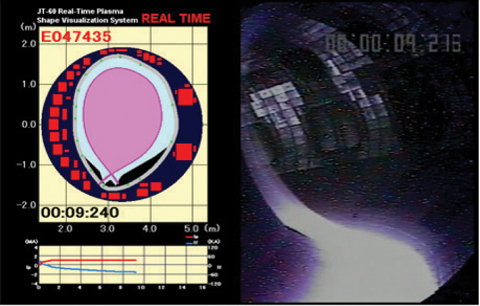
Fig.3-6 An Example View of Plasma Movie

Fig.3-7 Hardware Configuration of the Plasma Movie Database System
A plasma movie is one of the most efficient methods to convey what discharge has been made in the JT-60. This movie on a large TV monitor is able to provide various types of useful information in real time to the physicists; hot spots due to heat flow from a plasma on the vacuum vessel wall, time-evolution of plasma position and shape, change of macroscopic plasma rotation, etc. This innovative technology has contributed to safe, efficient operation, and has added an important chapter to the history of tokamak experiment. This real-time monitor has already be come an indispensable tool in JT-60.
This movie is composed of 4 elements: a video camera picture (right: Fig.3-6), a plasma cross section CG (left: Fig.3-6) generated by physics-based calculations from magnetic field measurements, a sound which is just the magnetic probe oscillation signal converted to audio, and a display of the waveforms of the plasma current and of the poloidal field coil current. This plasma monitoring system for JT-60 was the first developed in the world for tokamaks, and is still a unique feature of JT-60. The sound signal sometimes has a mysterious timbre originating from amplification of the raw voltage signal of a small magnetic field pick-up coil sensor in the vacuum vessel. This sound seems to imply various plasma states; changes in plasma rotation speed appear to cause changes in the tone of sound. A stable plasma produces smooth high tone as it rotates at a high constant speed. On the other hand, an unstable plasma has a noisy low tone as it rotates at an irregular speed.
The plasma movie database system (PMDS) converts analog to digital movie data using 2 compression methods (MPEG2 and MPEG4). The MPEG2 generates a high-resolution (large volume) data file which corresponds to the high definition TV, while the MPEG4, originally developed for the high-speed network broadcasting, generates a low-resolution, data file.
The hardware configuration of PMDS is illustrated in Fig.3-7. The plasma movie capturing system (PMCS) converts a movie to MPEG2 format compressing in real time, and records the resultant MPEG2 movie file automatically. Immediately after the MPEG2 movie is completed, the system starts converting from MPEG2 to MPEG4 format. When all the conversion is completed, the system transfers an MPEG4 movie file to the plasma movie web server (PMWS). Two formatted movie files are stored in corresponding databases. The PMDS checks what new movie files become available for distribution through the network every 10 minutes. A user can download a movie file from the database. This system has been configured using a personal computer with Windows XP and the existing network, which minimized the development cost and time. We solved a technical issue in efficient handling of the huge-volume movie data by employing 2 compression methods newly available in the market, as mentioned above. Since this system creates a movie file for every discharge in the JT-60 experiment sequence, it provides a movie with sound giving sensory support to the conventional understanding of each discharge using waveforms of time-series data. In addition, the physicists can use this system also for search of the latest interesting pulse discharge.
For conducting experiments on ITER and the satellite tokamak fusion device JT-60SA from remote sites, the physicists and operators at the remote site have to know what discharge is going as accurately and immediately as possible. This system could be also the key technology of such future remote experiment since it includes advanced real-time processing and movie data handling technology. It has already been used in a demonstration of JT-60 remote experimentation from Europe in Dec., 2007.